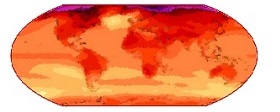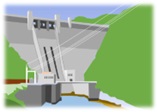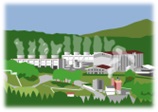
In recent years, Japan has experienced disasters due to abnormal weather, such as floods caused by heavy rain and roofs blown off by strong winds, due to global warming. Floods, droughts, forest fires and other disasters have also occurred around the world.
Global warming is making it increasingly difficult for people to live peaceful lives.
In order for people to continue living peacefully, we must reduce carbon dioxide, the most prevalent greenhouse gas that causes global warming, as quickly as possible and achieve carbon neutrality.
global warming

The Japan Meteorological Agency, Ministry of Land, Infrastructure, Transport and Tourism's "Global Average Temperatures in 2020 (Reiwa 2) (Flash Report)" states that "Over the long term, the global average annual temperature has been rising at a rate of 0.75°C per 100 years, and there have been many years with high temperatures, especially since the mid-1990s," indicating that global warming is progressing.
The main greenhouse gases that cause this temperature rise are carbon dioxide, methane, dinitrogen monoxide, and fluorocarbons.
As shown in the types and characteristics of greenhouse gases, carbon dioxide remains in the atmosphere for 1,000 years.
Carbon dioxide accounts for over 90% of greenhouse gases in Japan, Emissions from thermal power plants account for 32.4%, and emissions from automobiles account for 16.8%.In addition, emissions from the combustion of petroleum and city gas used for heating and hot water in the industrial and residential sectors account for approximately 10.6%.Carbon dioxide is generated as we lead convenient and comfortable lives.
The risks posed by global warming, as seen in the effects of global warming, are all threats to people's lives, and the increase in greenhouse gases has already led to global warming causing abnormal weather disasters that have affected many people.
We must achieve carbon neutrality as soon as possible and prevent global warming so that people can live in peace.
Carbon Neutral
In order to prevent global warming, it is essential to reduce carbon dioxide, which accounts for more than 90% of greenhouse gases and will remain in the atmosphere for 1,000 years, and achieve carbon neutrality.
We must achieve carbon neutrality by eliminating the use of heat and electricity that emit carbon dioxide by burning fossil fuels, and instead creating a hydrogen society that uses heat and electricity that emits water by burning hydrogen.
To achieve carbon neutrality, let's implement the following carbon dioxide reduction measures.
In the electricity business, we will phase out thermal power generation using fossil fuels and switch to electricity generated through renewable energies such as hydroelectric, solar, wind, and biomass gas power generation(livestock manure ,sewage sludge) .





Currently, if there is a large difference between electricity supply and demand, the entire power network will suffer a power outage, so the connection of solar and wind power generation, which fluctuates greatly depending on the weather, is restricted.
In order to eliminate these restrictions and allow for the expansion of solar and wind power generation, power network companie will install hydrogen electricity storage system on the sites of former thermal power plants and use this in conjunction with pumped storage hydroelectric generation to ensure that electricity demand and supply are simultaneous and equal through a Power supply and adjustment system
Electricity that emits carbon dioxide will be minimized through power generation using heat from incinerating general waste.
The gas business converts the supplied gas from natural gas, which is combusted to emit carbon dioxide, to hydrogen gas, which is combusted to emit water. The hydrogen to be supplied is generated by electrolysis of water using solid oxide electrolytic cells using electricity received from the power network, stored in a tank, and then supplied.
The transport sector will switch entirely from carbon-emitting fossil fuels to electric or hydrogen-powered operation.
Energy-storage ultra-fast charger that can be charged in just a few minutes will be installed at electric charging stations, offices, convenience stores, supermarkets, and parking spaces at roadside stations, allowing all vehicles to be driven by electric vehicles.
Aircraft will fly using hydrogen as fuel. At the airport, hydrogen is produced by electrolysis in solid oxide electrolysis cell facilities installed at the airport using electricity from the power network. The hydrogen produced and nitrogen from the air are used to produce ammonia using the high-temperature heat generated by a solid oxide electrolysis cell, and this is then stored in a tank. The aircraft transfer ammonia from a storage tank into the aircraft's fuel tank, converts the ammonia into hydrogen on board the aircraft, and uses the hydrogen engine to power the flight.
Just like an airport, a ship produces ammonia on the premises of the port, injects the ammonia into the ship's fuel tank, converts the ammonia into hydrogen inside the ship, generates electricity using a fuel cell, and operates the ship using an electric motor.
Railways and subways mainly run on electricity, but diesel locomotives on railways are replaced with electric locomotives, and ammonia is made on the premises of the depot in the same way as on ships, and ammonia is injected into the fuel tank of the electric locomotive. Ammonia is converted to hydrogen inside the locomotive, which is then powered by a fuel cell and powered by an electric motor.
At the factory, all fossil fuel boilers and electric boilers will be replaced with heat generating unit boilers, reducing consumption of hydrogen gas and electricity.
With these, carbon neutrality can be achieved.
Let's work together to achieve carbon neutrality so that people can continue to live in peace for generations to come.
"Quote":URL of copyrighted work
"World average temperatures in 2020 (Reiwa 2) (Flash report)"
https://www.jma.go.jp/jma/press/2012/22a/2020matome_besshi3-1.pdf
"Next-generation highly efficient hydrogen production technology "solid oxide electrolytic cells""
https://www.mhi.com/jp/news/240425.html
"Small-scale ammonia production facility for industrial use"
https://tsubame-bhb.co.jp/news/cat01/5019/